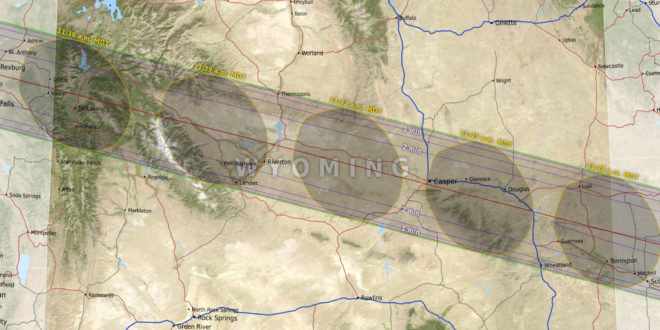Emergency officials in Teton County are preparing for a crush of visitors to Grand Teton National Park for the 2017 solar eclipse.
And it almost goes without saying: they’re preparing for any mishaps.
Monday, August 21, the moon will pass in front of the sun, prompting a total solar eclipse across a narrow band of the United States. The event will last approximately from 10:15 a.m. to 1 p.m.
Both Grand Teton and Teton County are expecting a high amount of people in the area, according to the Jackson Hole News & Guide. Indeed, Grand Teton officials expect August 21 to be the single busiest day on record in the park’s history. Teton County officials estimate more than 50,000 additional visitors will be around for the eclipse, almost double the average for this time of year. From the Guide:
“We don’t know and we are not making an estimate,” Teton County Emergency Management Coordinator Rich Ochs said Monday at the last planning meeting before the event.
The moon will take its first bite of the sun starting at about 10:16 a.m. Monday, Aug. 21. It will reach totality — the sun completely obscured and the darkness total — at 11:35 a.m. Totality will last about 2 minutes and 14 seconds. The sun will be back to normal just after 1 p.m.
The center line of totality runs through Jackson Hole Airport, about 9 miles north of town. That area is expected to be the center point of attention for tourists.
All organizations — Grand Teton National Park, the Bridger-Teton National Forest, Jackson Hole Airport and others — are going to try to count visitors for a combined estimated total when it’s all over with. But they say there’s really no way to count heads, just cars.
But officials are more worried about public safety than they are about counting people.
“What we are trying to do here and what we’re trying to accomplish is getting these multiple agencies and jurisdictions together so that we can coordinate, collaborate, communicate and cooperate — the four Cs,” Ochs told the room filled with about 40 first responders.
Personnel with Teton County, the town of Jackson, Grand Teton National Park, the Bridger-Teton National Forest, the National Elk Refuge, the Jackson Police Department, Jackson Hole Fire/EMS, Teton County Search and Rescue, the Teton County Sheriff’s Office, Teton Interagency Fire, Teton Village, St. John’s Medical Center and Jackson Hole Airport have been planning for more than two years under the guidance of Teton County Emergency Management and an eclipse coordinator.
“The EOC [Emergency Operations Center] is trying to serve that role of supporting the different incident management teams in the field and making sure we are all talking to each other,” Ochs said.
“The boundaries we have for jurisdictions, the visitors who are coming here for the eclipse have no idea what they are. They have no idea if they’re standing in the park, the forest or the airport. It’s incumbent on us to make sure we deliver public safety services in an efficient and coordinated manner and make sure that people have a good time.”
The two biggest emergencies officials may have to deal with include traffic accidents and eclipse-related injuries; staring at an eclipse when it’s not total darkness can cause permanent eye damage, which will necessitate a trip to the hospital.
According to the Guide, Teton County officials will spread themselves across Jackson Hole to make sure they can reach people swiftly.
 Yellowstone Insider Your Complete Guide to America's First National Park
Yellowstone Insider Your Complete Guide to America's First National Park





